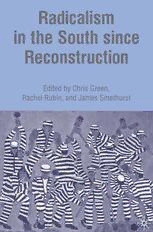
Radicalism in the South since Reconstruction PDF
Preview Radicalism in the South since Reconstruction
RADICALISM IN THE SOUTH SINCE RECONSTRUCTION This page intentionally left blank RADICALISM IN THE SOUTH SINCE RECONSTRUCTION Edited by Chris Green, Rachel Rubin, and James Smethurst radicalism in the south since reconstruction Copyright © Chris Green, Rachel Rubin and James Smethurst, 2006. Softcover reprint of the hardcover 1st edition 2006 978-1-4039-7409-9 All rights reserved. No part of this book may be used or reproduced in any manner whatso- ever without written permission except in the case of brief quotations embodied in critical articles or reviews. First published in 2006 by PALGRAVE MACMILLAN™ 175 Fifth Avenue, New York, N.Y. 10010 and Houndmills, Basingstoke, Hampshire, England RG21 6XS. Companies and representatives throughout the world. PALGRAVE MACMILLAN is the global academic imprint of the Palgrave Macmillan division of St. Martin’s Press, LLC and of Palgrave Macmillan Ltd. Macmillan® is a registered trademark in the United States, United Kingdom and other countries. Palgrave is a registered trademark in the European Union and other countries. ISBN 978-1-349-53466-1 ISBN 978-0-230-60178-9 (eBook) DOI 10.1057/9780230601789 Library of Congress Cataloging-in-Publication Data Radicalism in the South since Reconstruction / edited by Chris Green, Rachel Rubin, and James Smethurst. p. cm. Includes bibliographical references (p.) and index. 1. Radicalism—Southern States—History. 2. Southern States—Social conditions—1865-1945. 3. Southern States—Social conditions—1945- 4. Southern States—Politics and government—1865- 5. Social change—Southern States—History. I. Green, Chris, 1968- II. Rubin, Rachel, 1964- III. Smethurst, James Edward. HN79.A13R3 2007 303.48’4—dc22 2006045817 A catalogue record for this book is available from the British Library. Design by Macmillan India Ltd. First edition: December 2006 10 9 8 7 6 5 4 3 2 1 Dedicated to Lucy Mason, George Meyers, and Lorenzo Thomas and to our children This page intentionally left blank CONTENTS radicalism in the south since reconstruction: an introduction 1 Chris Green, Rachel Rubin, and James Smethurst Essays the afro-american council and its challenge of louisiana’s grandfather clause 13 Shawn Leigh Alexander “the first anarchist that ever came to atlanta”: hiram f. hover from new york to the new south 39 Bruce E. Baker mobilizing the reserve army: the communist party and the unemployed in atlanta, 1929–1934 57 James J. Lorence agnes “sis” cunningham and labor songs in the depression south 83 Ronald D. Cohen the tight rope of democracy: don west’s CLODS OF SOUTHERN EARTH 99 Chris Green black arts south: rethinking new orleans and the black arts movement in the wake of hurricane katrina 129 James Smethurst viii / contents the great anti-injunction strike of 1976: context and implications for appalachia 149 Lynda Ann Ewen critik: the institute of the black world (ibw), the political legacy of martin luther king, and the intellectual struggle to rethink america’s racial meaning 167 Bill Strickland southern theater for social change 191 Pat Arnow Interviews beluthahatchee blues: an interview with stetson kennedy 211 Jorge Arévalo Mateus “we don’t have much time”: an interview with raúl salinas 227 Rachel Rubin “the anti-slavery act of 2002”: an interview with si kahn 239 Rachel Rubin brief notes on contributors 255 index 259 Radicalism in the South since Reconstruction: An Introduction Chris Green, Rachel Rubin, and James Smethurst “Never take a shit on your own time.” That, according to the lifelong Southern radical George Meyers, was his fi rst lesson, taught to him in 1933 by a helpful co-worker on his fi rst job, at the Celanese textile plant near Cumberland, Maryland. It was his fi rst shift in the spinning department and his stomach was churning from the stench of acetone fumes and the air temperatures of over 100 degrees, so during the “lunch” break (in the middle of the 11:00 p.m.–7:00 a.m. shift) Meyers had dashed to the bath- room. His friend’s emphatic advice may sound amusing with the distance of time, but it was actually a sound and suggestive dictum for a budding activ- ist. Labor struggles always return to the regulation (even legislation) and exploitation of bodies, as crystallized in the slogan from a Harlan County, Kentucky, miners’ strike in 1974: “The Duke Power Company May Own the Brookside Mine but They Don’t Own Us.” Further, who “owns” a worker’s time is one of the foundational philosophical puzzles of capitalism. Meyers’s friend was sincerely urging him to act in his own class-based self- interest, through what we must recognize was a job action that, while small, revealed the power relations in industry at the most basic level. In 1998, at the age of eighty-fi ve, Meyers suffered a stroke. Hoping to help him pass the time as he recovered, his doctor suggested that he start to write his memoirs. The doctor had no academic aims, but from what he knew of his patient, there was good reason to think it was an enter- prise that would occupy him productively for some time. Meyers had a long history as a radical labor leader, stretching from the coalfi elds and textile mills of Depression-era Appalachia to regional leadership of the Congress of Industrial Organizations (CIO) and national leadership of the Communist Party of the United States (CPUSA). The Baltimore Sun had recently colorfully profi led him under the headline “Better Red,” giving some sense of the scope of his remarkable life. Moreover, Meyers enjoyed a good story; according to the Sun profi le, he “salt[ed] his conversation
